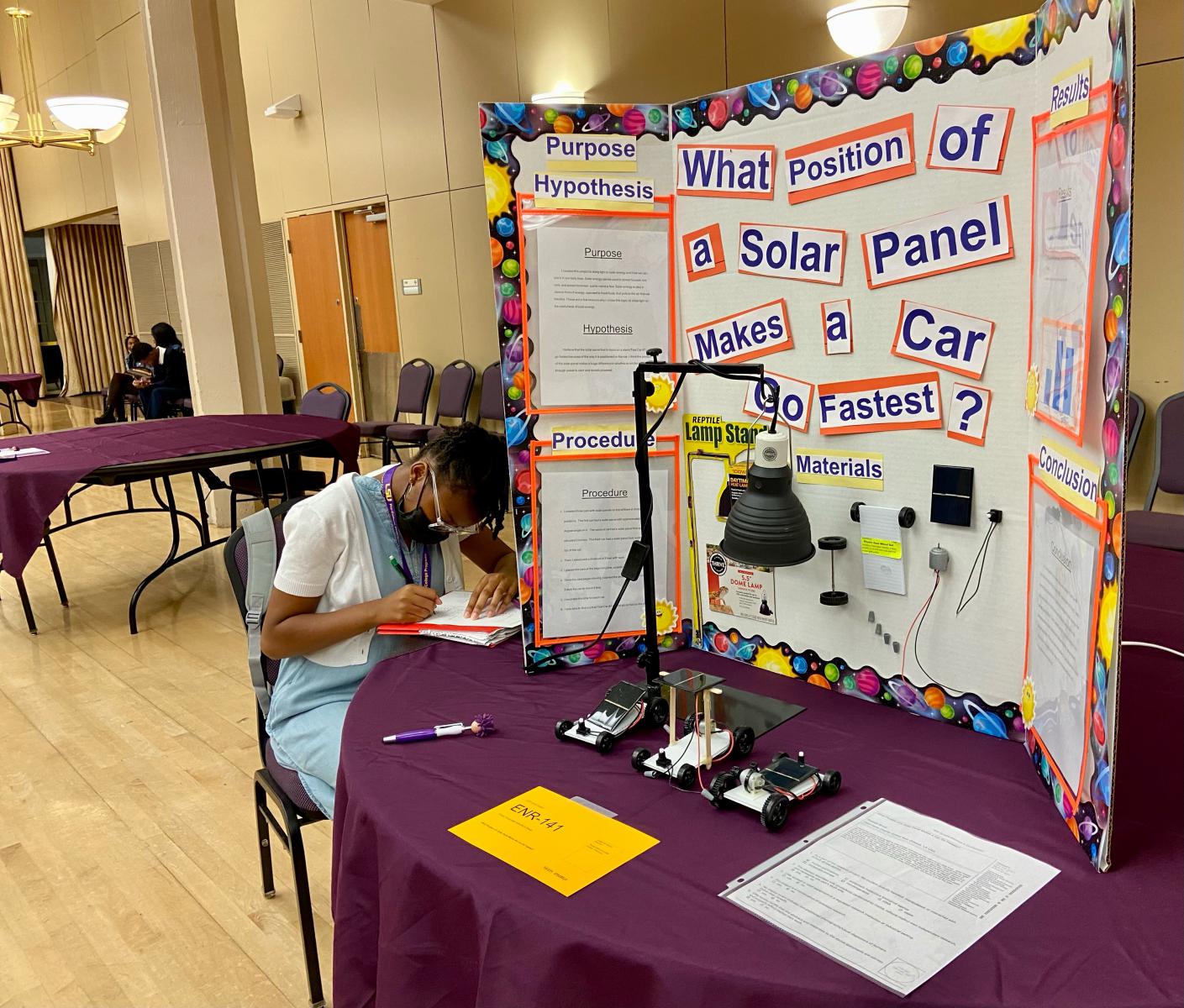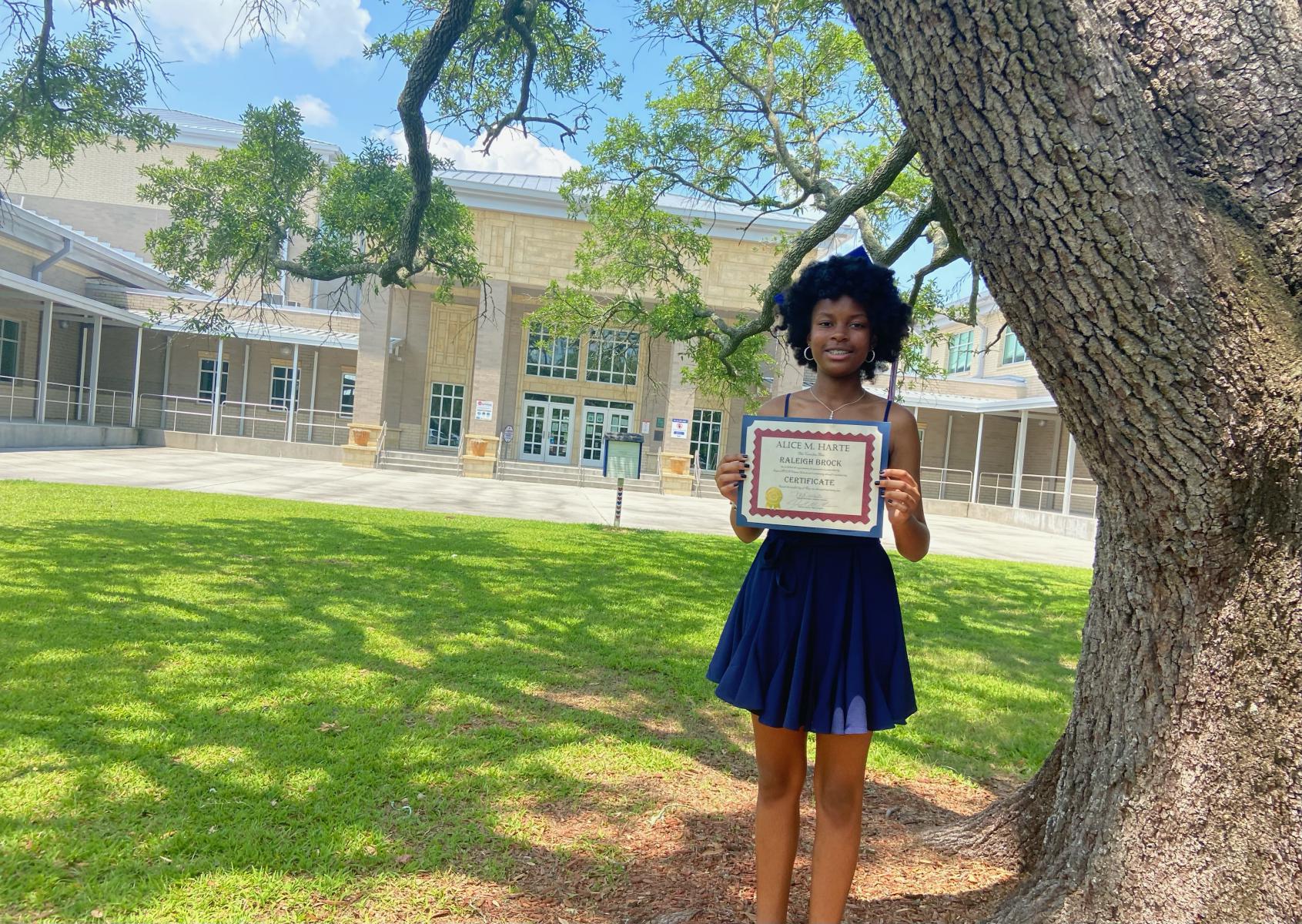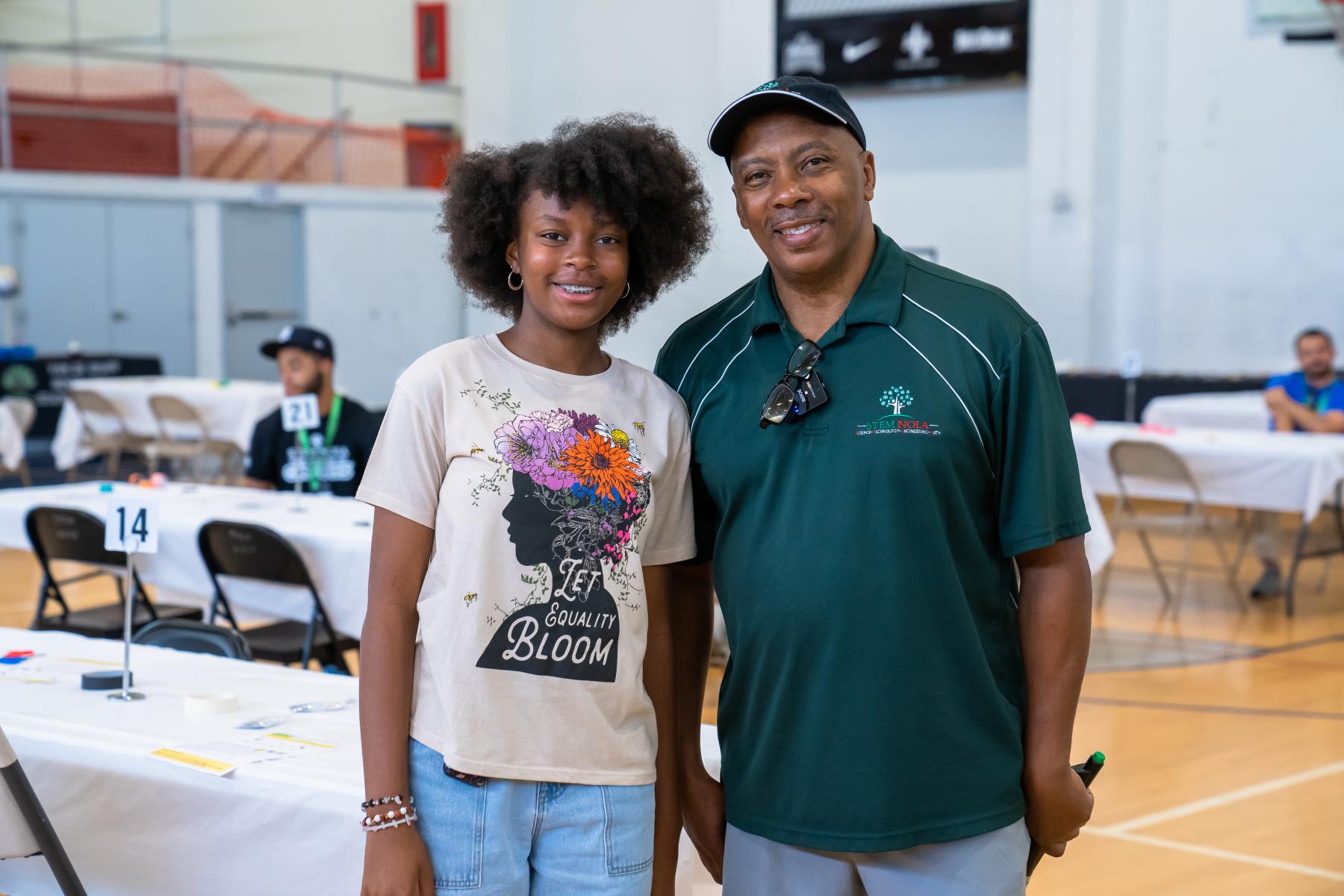
Raleigh’s award-winning science project featuring scholar cars
NEW ORLEANS – As Raleigh Brock, an 8th grader, rode with her mother, Alyssa, from the Fox TV station where she was just interviewed about her award-winning science project, something astounding occurred in the back seat. Her younger brother, Royce, 7, turns to her, acclaiming: “You know, Raleigh, you are a good role model for me.”
Then, as mom and sister ruminate over his words, Royce ensures his comment is taken with the gravity intended. The youngest Brock adds: “I’m not being sarcastic. I’m serious.”
His words accentuate the message that his sister is very special. And Royce is not the only one taking notice these days. At 14, the aspiring astrophysicist, planetary scientist and engineer is demonstrating a keen awareness and understanding of science, technology, engineering and math (STEM) skills and principles that is astonishing for someone her age. Even more so for an African American student attending an inner-city school.
Her awards and honors keep rolling in.
First place at her school science fair. First place at the Greater New Orleans Science Fair. First place at the Louisiana Science and Engineering Fair junior division, a special award in the transportation category and a $200 prize. Now, Raleigh is competing in the NAACP Afro-Academic, Cultural, Technological and Scientific Olympics, a yearlong achievement program designed to recruit, stimulate and encourage high academic and cultural achievement among Black high school students. Raleigh won first-place in the engineering division in April and will represent New Orleans at the national NACCP ACT-CO convention in Atlantic City, NJ in July.
How does Raleigh reach such lofty heights in STEM-related activities when so many Black & Brown students like her in communities across the country struggle, or are even intimidated, by math and science? Her story, a narrative about her initiative, brilliance and determination at a young age, also demonstrates what our children can accomplish with love, encouragement, communication and discipline from parents and access to extracurricular programs that take education beyond the classrooms and engage children with challenges that motivate them.
Raleigh comes from a family of educators. Her mother, Alyssa, is a first-grade teacher at the Alice Harte Charter School, where Raleigh attended before graduating to the nineth grade in the fall. Raleigh’s maternal grandmother, maternal great-grandmother and paternal great-grandmother were also teachers. “We take that job (teaching) pretty seriously,” Alyssa says. Raleigh’s parents have always stressed “soaking up as much culture as possible,” and take their children to museums and other attractions.
That has been the case in New Orleans, as well as the four years they spent in Illinois. “I’m pretty much one of the go-to people with events that are taking place in whatever city we are in,” says Alyssa. “We like to take advantage of everything that cities have to offer. And I think just doing those types of things contributed to our daughter’s and son’s overall wellbeing and education. We pay close attention to the social and emotional part of our children’s lives. And we try to be good role models. On one is perfect. But even when we have situations, we try to navigate through those situations in the best way possible.”
The children are trained to be good problem solvers. “I think they are just natural problem solvers now,” Alyssa says. “We are the type of parents where if you don’t have an answer you must try to find one. We’re always there to support them, but we like for them to come up with answers themselves because in this world you have to; you have to be able to solve problems. And, you know, I guess that kind of transcends into the whole world of science and STEM.”
Alyssa describes Royce as “naturally inquisitive” and “highly intelligent.” She says, “Royce is like a teacher’s dream because he wants to know everything. He surprises me. Like sometimes, I have to say, ‘You’ve reached your question quota for the day.’”
Her father, Roderick, who is a supervisor with Otis Elevator, says the keys to good parenting are guidance, understanding, encouragement and honesty. “As parents we are allowed to teach, develop and encourage our kids,” he adds. “But most important is honesty and understanding, this allows us to learn and help them reach their full potential and goals. Everyone evolves together.”
Back in 2015, Raleigh began participating at STEM NOLA, a program pioneered by Dr. Calvin Mackie that prioritizes advancing STEM education in Black & Brown communities. A year ago, the award-winning program was rebranded as STEM Global Action and their affiliates, including STEM NOLA, have impacted more than 100,000 students, 20,000 families and 5,000 schools in New Orleans, in Louisiana, across the U.S, and in five countries.
STEM Saturdays, which provide a range of STEM activities, were a staple for Raleigh. “When I started out at seven years old, we did simple projects, like making boats that floated. And, I remember once we got into higher grades, we started dissecting things and doing more complicated projects. I remember we started making airplanes. And, the higher you go and the older you get, the more, and the better, the experiences. The projects became more and more challenging.” Royce now follows in his sister’s footsteps at the STEM NOLA events.
Raleigh elaborated on how the STEM NOLA experience deepened her educational development, especially pertaining to science, and more importantly opened her mind to possibilities she had never imagined. “Well, it made me like it (science and engineering) more because it opened my world to something new, some things that I never really knew about before. And, I love to experience new things. I just wanted to experience another path in life, something different from what I had seen previously.”
Further, the insightful teen adds: “My biggest takeaway would be that if you open yourself up more to STEM and the many things that are around you, and look at everything in a different light, then maybe you can go for something greater in life than what you originally planned.”
Alyssa saw the STEM Saturdays affect her, too. “The hands-on aspect of it really helped her. Every STEM Saturday there’s always a build component. You can pretty much put anything in front of Raleigh and whether she can build by following the instructions or on her own, there’s no ‘I can’t do this’ because she’s built so many different things. In school, there is a lot of focus on literacy and not as much math and science, so just having the opportunity outside of school to use those skills had a big impact.”
Roderick also sees the STEM NOLA influence on his daughter. “STEM NOLA has been a great motivating tool for Raleigh,” he says. “They offer guidance, encouragement and understanding. Dr. Mackie and his team is a great source of energy for the both the kids and the parents. “
Dr. Mackie asserts that his programs are designed to allow children to have fun, while learning more about STEM. “Our kids need to build confidence that they can achieve at science, technology, engineering and math. They are not getting that in many of the schools they attend,” he says. “We call them ‘Lost Einsteins’ when brilliant Black & Brown children are not nurtured, not exposed to STEM, and lose out on the skills and learning that will be needed to fill the jobs and careers of the future. Raleigh is an example of what our children can accomplish.”
STEM NOLA was the beginning for Raleigh’s science project that has been lauded for its forward-thinking, and potential contribution to curbing climate change. At STEM NOLA, Raleigh had built a solar car. For her project, she wanted to demonstrate the link between the placement of solar panels on cars and the efficiency of solar energy.
“I created three cars and I positioned the solar panels differently,” she says, of her project. “One of the cars had Popsicle sticks on it to make the solar panels higher, another one was slanted on the motor and the last one was flat on the top of the car. I experimented outside to see which one went fastest in a three-foot distance. It’s to show that if you use solar energy, you can help the environment more because we use gas a lot. If you use solar energy, you can see how far it can take you. The more solar energy you use, the better we can do for the environment.”
How did she get the idea?
“I was having a conversation with my mom about doing a science fair project,” she recalls. “I didn’t want to do a simple science fair project just to get my grade. I wanted to do something bigger than that. So, we talked about things going on around the world. And, that’s when we I saw a solar panel on a house, and I thought I could do it on a car.”
Raleigh has always been intrigued by building things. “I think it came from a very young age because I’ve always loved building things; just building things in general was fun. I always played with Legos. And, I think just building things, period, is fun for me.”
Competing in competitions, and getting to travel has created new experiences, ones she is thrilled to be a part of. “I’m very excited. I get to go out of a state for the NAACP achievement program. “I want to be a tourist for a while. But I’m also excited because I like competing in competitions. It’s thrilling because you have to wait a while to see if you win. And, it also provides opportunities to see the kinds of things that others think about and do. “
Raleigh recalls the state science fair at LSU. For the first time, she noticed that the spotlight was on her because of the work and thought she had put into her project.
“I remember turning on my cars and the heat lamp and everything. I remember everybody kind of looking at me and I remember feeling like I was in the spotlight. It seemed like it was pretty cool to them. I guess they liked my project, but I can’t really tell what they said about it, but it looked like they really liked it.”
Clearly, to her friends and classmates, Raleigh is a Rock Star. She is embraced for her achievements in STEM.
“Well, I fit in pretty well with my friends,” she says. “I told them about being on the news today. They were very supportive of me. They find all of this a very cool thing. They don’t tease or bully me about it. Even my classmates. I remember when I won competitions, they were the ones coming down the hall with me, happy and celebrating. They were congratulating me. They were always on my side and no matter what, they never just, you know, just said it was something stupid. They always thought it was very cool. And even their parents did as well.”
What can we expect from Raleigh, the 14-year-old, special achiever and role model, in the future?
“Well, I want to be an astrophysicist and a planetary scientist. But it will also be cool to be an engineer. I’ve always wanted to work at NASA or something in the space field. It draws my attention because I’ve always thought, since I was young, that we aren’t the only people in the universe and I’ve always wanted to try to discover that and see if I could at least find something else out there. With all the movies that I’ve watched, I’ve always been curious of what’s outside of my world.”


